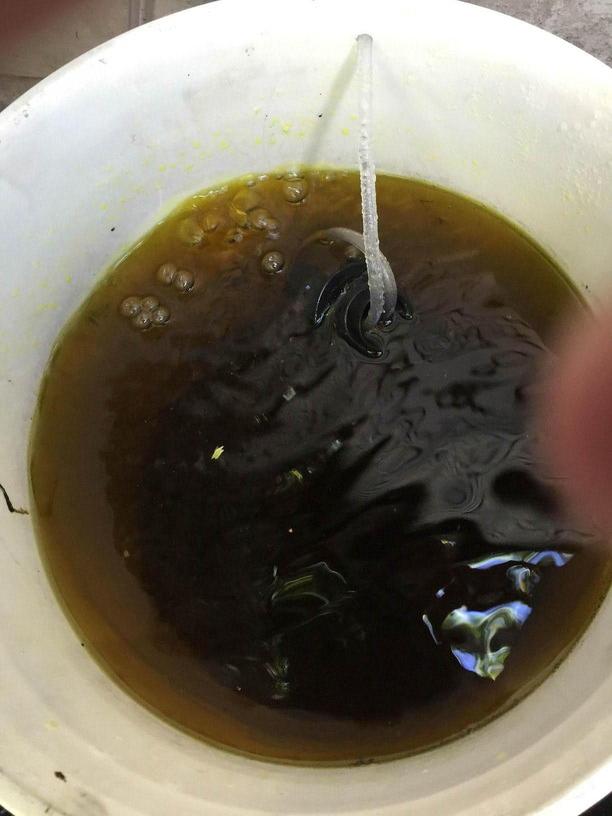Geo said:
Colloidal gold is a solid. The particles are so small that they take a very long time to settle out of solution. The purple color of a positive for gold is metallic gold precipitated by the tin chloride.
I know what the problem is with your process. Anyone that has used AP would know and I can't believe that no one has told you. I will tell you again, for AP to work properly, you must use an oxidizer. Since H2O2 will dissolve gold, that leaves adding oxygen from the air. You need an air pump. This no guess, it is the cause of your problems. To keep trying to do this without doing what has been explained to you and then coming back and asking what could be going wrong makes it seem like your just being hard headed about it. I'm not trying to be rude at all. You need volume. A few cups of solution is not enough. Since AP is not like AR where you need to use as little as possible, you need an over abundance of solution for it to work smoothly. You need to use an air supply. This is not an optional part of the process. You need an air supply or it will take months to dissolve a few ounces of metal. If you can't find one or buy one, without an air pump, I'm not sure you will ever be able to make the process work. Please don't come back in ten or twenty post saying that the solution has been in there for three months with you just giving it a few shakes ever so often and it's still not dissolving the base metal. Go get and air pump and plug it up. Dilute some HCl with water in a 50/50 mixture and add it to the process even if you have to use a bigger container. Once you do what we have been trying to tell you, you will see the difference.
That's where I've gone wrong. I thought that the added oxygen in peroxide WAS the oxidizer, a mistake on my part. Seems to work for gold fingers though, but pins do have alot more metal to dissolve.
It's not that I was being hard-headed, it's that I'm 1 of the people that has an easier time watching someone else, than it is reading about it, unless it's a long drawn out explanation so I don't end up missing certain parts (That's most likely why I usually write long paragraphs also). I actually came to this site after watching a bunch of videos on the processes, and this site is the best place to fill in the missing parts.
So basically, as soon as I get a bubbler, instead of using these small mason jars, I could put my 3+ lbs of pins into a 5 gallon bucket, along with 3 gallons of HCL or so, and a very small amount of peroxide to get the process started, turn the bubbler on, and just let it go, checking on it every couple days and turning it off periodically when I need to. Then once everything looks to be dissolved, filter it, check the solution with stannous, and start the disposal process, or recharge the used AP and move on from there.
I wasn't planning on making an abundance of solution because of pets and my nieces, but if I can find a good place to set the bucket so they won't be able to get into it, I'll definately be doing that because, I do have quite a bit of material to process.
The cheapest bubbler I've seen at the pet store was $30, that's why I haven't bought 1 yet.
jason_recliner said:
Shaking acids, in a literal sense, is probably not the safest of things to do. I will assume he meant sloshing or swirling, while his main focus was on its ineffectivity.
Yes, it wasn't working. I was tightening the lid, and moving the mason jar up and down, in circles etc, (gently) for 30 seconds or so a couple times per day and/or using a long plastic spoon to mix around the pins. So, it would be more sloshing it around than actually shaking it because the metal pins in the jar could end up breaking the glass, which would most likely get me covered in acid and that definately wouldn't be fun.
Shark said:
In my opinion, an air supply is a must for AP to work correctly. I have tried it without one and hated it, it took what seemed like forever. A simple air pump for a fish aquarium can be bought at Walmart for around $7 and a double a pump for around $12. That is pretty cheap for a tool to recover your gold. It will also greatly speed up the time it takes to recover it. Do your self a real favor and get an air pump, you won't regret it for the cost.
This is great news, that's a much better price than the pet store. The Walmart near me doesn't have an aquarium section for some odd reason but, I forgot that the other 1 a couple towns over does, so Ill be heading that way very soon.


















































































